This is the final part of a series of three posts about spawning aggregations of bumphead parrotfish and Lutjanus bohar red snappers in Palau.
I'm going to cover practical information about getting to the spawning aggregations with Blue Marlin, share a few wrap-up thoughts, and set out dates for my next planned trip with the bumpheads and snappers in case you'd like to join me.
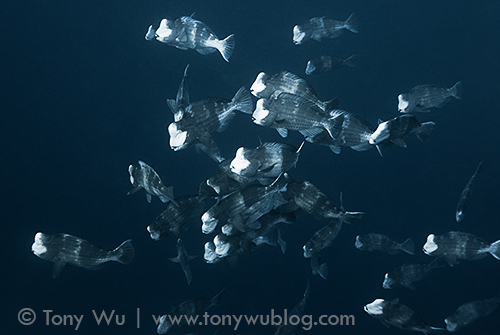
Bumphead parrotfish (Bolbometopon muricatum) preparing for group sex
Spawning Stuff
Diving with the spawning events isn't terribly difficult, but not necessarily easy either.
Spawning takes place in the early morning (departing pre-dawn is normal), which means being mentally and physically alert at a time of day that most people are not accustomed to. It also means low light, which has obvious implications for seeing in the water, and for photography as well.
Spawning of the two species I've discussed takes place around the moon cycles (bumpheads at new; snappers at full), and although it's not clear exactly why the fish choose the time and places that they do, personal observation and common sense suggest that they prefer to engage in spawning when visibility is poor and currents are optimal for dispersing fertilised eggs out to sea as quickly as possible.
Both of these considerations would help to maximise success and survival of progeny. Both also make diving and photography a challenge.
Of the two species, the bumpheads are probably somewhat easier, because the current tends not to be as strong (though it can be ripping with them sometimes as well). But in both cases, there are important considerations, which I'll discuss below.
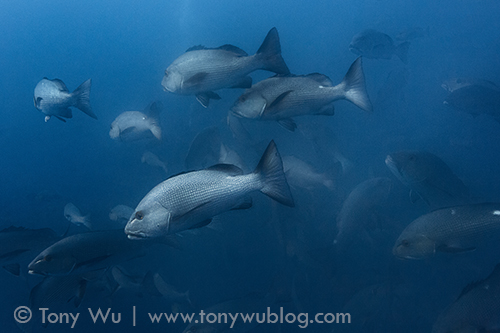
The fog of fish sex. This is what it looks like inside a massive group of spawning Lutjanus bohar snappers.
Diving with Blue Marlin
So...if you're interested in visiting Palau to give the spawning aggregations a try...here's the rundown on diving with Blue Marlin.
First off, the dive shop is located the water, on the premises of the Palau Royal Resort, which is a beautiful property. The shop is Japanese-owned and managed, and as you might expect, is extremely well-organised and tidy.
If you look at their newly minted English website, you'll see photos of the shop, boat dock, hot(!) showers, huge rinse tanks for gear, a nice gift shop, and other facilities. (For the guys - the cute, smiling Japanese girls aren't always standing at the rinse tanks, so don't get your hopes up.)
The team is headed by Ishiura-san (Ishi) and Tominaga-san (Tomi) with a full complement of Japanese, Palauan and Filipino staff. Click here to see the team.
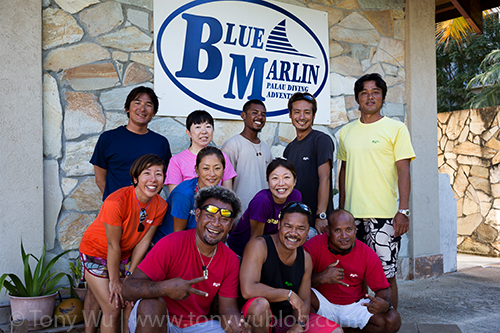
Smiling faces of the Blue Marlin team
Now...assuming most of you reading this are not Japanese speakers...the people you'll most likely work with while you're in Palau are Clayton and Jordan, who are the two Palauan dive guides.
Remember I mentioned Clayton in my earlier posts? Well, here he is:
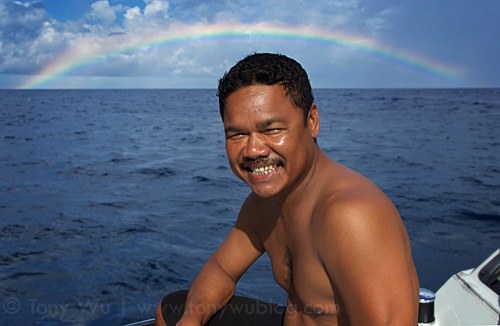
Clayton, aka "Rainbow Boy"
When you meet him, feel free to call him Rainbow Boy. Or if you live in Palau and read this, please call him Rainbow Boy right away. He likes it (insert smart-alec wink emoticon).
All kidding aside, Clayton and Jordan know their stuff. I spent most of my time with Clayton (poor guy), and I can say, hand to my heart, that he is awesome with the aggregations. Don't let the laid-back Palauan demeanor fool you. Clayton has devoted a lot of time and effort to making sure he knows exactly what is going on with the fish, which was instrumental to getting my friends and me to the right place at the right time.
And of course, with over 20 years of diving experience in Palau, Clayton knows the standard dive sites like the back of his hand, so if you're hoping to dive the well-known sites, he's great for that.
Some key aspects of diving with Blue Marlin:
- The standard day comprises two dives, so on a normal day (not a spawning aggregation day), you'll probably head out around 08:30-09:00 and be back in the early- to mid-afternoon. It is possible to arrange a third dive for the day, given boat availability. The boats are similar to the all the other canopied, single-hull designs used for diving in Palau; they're well maintained and comfortable. Blue Marlin has Nitrox available if you'd like to use EANx, and there is rental gear available too.
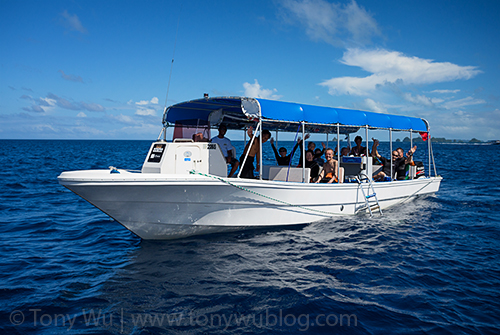
One of Blue Marlin's dive boats
- If you want to go for spawning dives, you'll need to contact the shop in advance specifically to arrange those dives, subject to availability of space. There's no showing up and jumping on the boat. Your day will start early, how early depends on the tides and light. My preference was to head out for the spawning dive, then stay out for a couple more dives, heading back in during the early afternoon. There is some flexibility in this, but keep in mind that spawning occurs only at certain times. The fish will not amend their schedule to suit your circumstances.
- Japanese discipline is pervasive. The facilities are clean, neat, efficient, and there's a system for washing and storing your gear so you always know where it is. If you've ever visited or lived in Japan, you'll know what I mean. Oh...one thing you might want to pack is a mesh bag that holds all your gear. That'll make it really easy for you to fit right into the system for handling gear. The gift shop has really nice big mesh bags for sale if you forget yours. I bought a couple because they're big enough to fit all my stuff.
- You will most likely not be mixed in with divers from Japan. Besides the obvious language issues, there are differences in diving culture and practice.
- Lunches are bento boxes, which you can pre-order the day before. There are a couple of dozen variations from which to choose. I love bento lunches, so this was perfect for me. Ditto for everyone who travelled with me. If for some reason you have food issues, it's best to let them know in advance.
- Neoprene boat coats. I looovvveee these. Blue Marlin has a bunch of these coats available for everyone who dives with them to take out during the day (and return of course!). Even though you're diving in the tropics, it's easy to lose body heat. I get cold quickly; having one of these neoprene coats to put on after every dive makes life downright pleasant. And believe me, when the squalls hit, you will wonder how you ever got along without one of these coats.
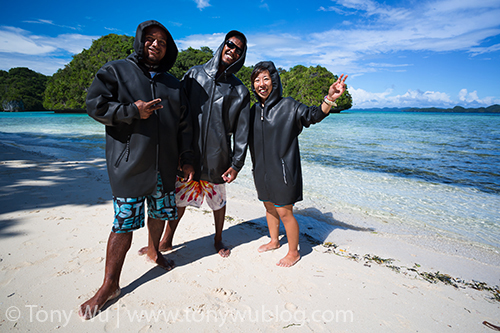
Neoprene boat coats from Blue Marlin. Don't leave home without them!
Considerations for trying the spawning dives with Blue Marlin:
- As I mentioned in both previous posts, being fit helps. A lot.
- Whatever happens, stick with Rainbow Boy (or whoever your guide may be). Bear in mind that there are risks involved. Not extraordinary ones, but things you need to be aware of and take into consideration. With the early hour, low light conditions, open ocean environment, steady current, rapidly changing depths, and the chaos of frenzied fish activity, you must be a very good diver. If you've just started diving, or aren't confident in the water in the event you find yourself alone, in a current, in the blue, with no visual reference...then think twice, three times for that matter. Keep in mind that the action is fast; visibility low; and everyone's attention will be on the fish, not necessarily on you. Carrying a safety sausage (and knowing how to use it) is standard procedure in Palau, but for these dives, it's that much more important.
- Safety, safety, safety. If you want to try the spawning dives, you will need to dive for at least one full day with Blue Marlin prior to attempting the early morning dives. This is to ensure that all your gear works properly, and that your diving skills are up to par. The snapper dives can be particularly tough. You should have at least 100 logged dives; have full control over buoyancy; be able to descend very quickly when required (a necessary skill for diving in strong current); and be able to swim against the current. If your skills aren't sufficient, you may not be able to join the morning dives.
- Check your ego at the door. Sometimes it seems that divers carrying cameras lose sight of what's important (i.e., appreciating the experience and having fun), with too great an emphasis on trophy hunting and bragging rights in the form of pictures. If you visit Palau to give this a try, stay focused on, and appreciate, the fact that you are witnessing some of nature's most amazing spectacles. Don't be the person who elbows others out of the way, charges in front of other divers, or takes off on your own thinking you know better.
- Play nice. Coming out of our experience of working together, Blue Marlin has decided to take on divers who are not Japanese. This is a big step, as Japanese-owned dive operations tend not to cater to people who are not Japanese. They have a lot to offer, as you've seen in this series of posts. I'd really like them to succeed, and for everyone to have fun. If you encounter any issues that you need to discuss with the management of Blue Marlin, keep in mind that English is not their native tongue, and that there may be cultural differences pertaining to your issue at hand. Please don't make them regret stepping outside their comfort zone, and don't make me regret sharing this information with you. For what it's worth, nine friends accompanied me on my trips with Blue Marlin, and everyone had a superb time (Thanks Ai Lin, May, Sallie, Julian, Ildi, Jenny, Dan, Kozy, Nana!).
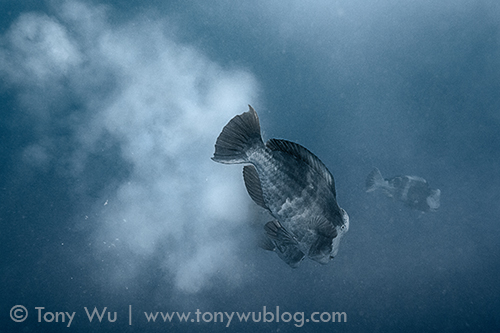
That's a lot of spawn from just a couple of fish!
Travel with me to Palau, Nov/ Dec 2013
Finally, to wrap up, I'm going back to Palau in November and December this year to have another go with both the bumpheads and snappers.
You can, of course, plan your own trip to see these spectacles, but if you travel with me, you'll have the benefit and pleasure of listening to me blather non-stop, and of watching me annoy Rainbow Boy, a pursuit at which I excel.
There's limited space, so please contact me if you'd like to join the fun.
Thanks for reading.
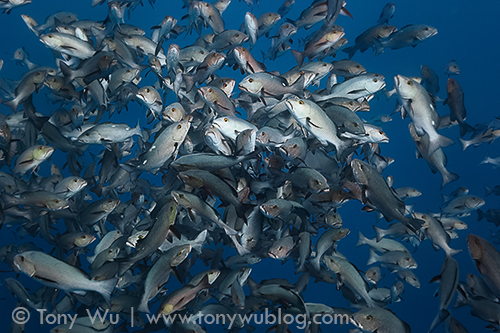
Lutjanus bohar snappers aggregating before spawning en masse
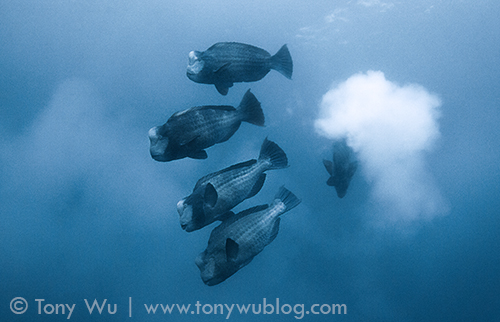
More fog of fish sex: bumphead parrotfish sperm and eggs clouding up the water.
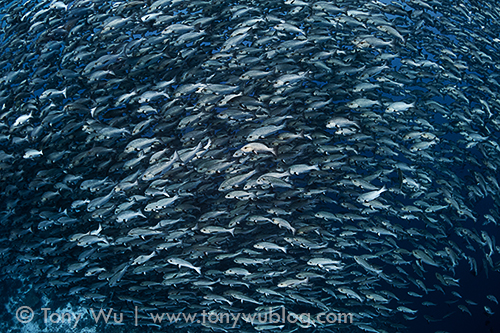
A wall of two-spot red snapper (Lutjanus bohar) in Palau
Related Posts:
Part 1: Bumphead Parrotfish Spawning Aggregation in Palau
Part 2: Lutjanus bohar Two-spot Snapper Spawning Aggregation in Palau